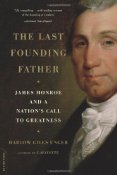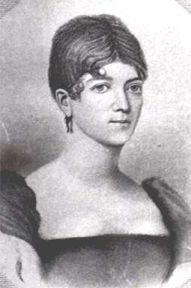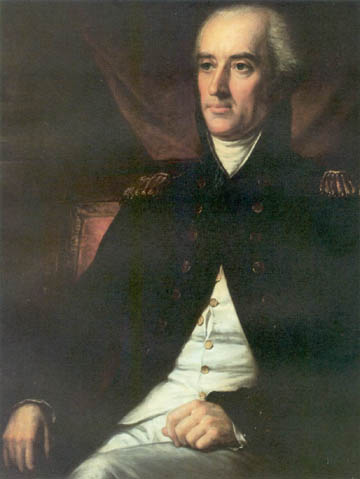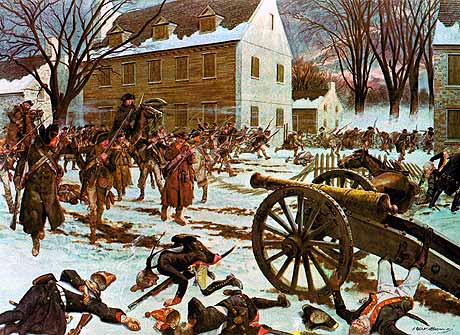
The Last Founding Father – James Monroe and the Nation’s Call To Greatness by Harlow Giles Unger
 What a guy! That is the phrase that now comes to mind after having read Harlow Giles Unger’s biography of James Monroe. Monroe was the president that every American yearns for. Unger paints a picture of a man who was brave, honorable, kind, smart, and, well, manly. After you read this book, one thought persistently intrudes on your mind: “I wish we had presidents like that today!” It is a feeling similar to the one you get watching the movie Airforce One. The hero of that film is the President of the United States, played by Harrison Ford. In the movie, Ford’s character is a kick-butt ex-fighter pilot. The movie is fun and inspiring. The difference is, the movie is fiction, while the story that Unger tells is fact.
What a guy! That is the phrase that now comes to mind after having read Harlow Giles Unger’s biography of James Monroe. Monroe was the president that every American yearns for. Unger paints a picture of a man who was brave, honorable, kind, smart, and, well, manly. After you read this book, one thought persistently intrudes on your mind: “I wish we had presidents like that today!” It is a feeling similar to the one you get watching the movie Airforce One. The hero of that film is the President of the United States, played by Harrison Ford. In the movie, Ford’s character is a kick-butt ex-fighter pilot. The movie is fun and inspiring. The difference is, the movie is fiction, while the story that Unger tells is fact.
In our reading about the history of this country, we’ve discovered that, unsurprisingly, the Founders had their faults and foibles. Many were heroes, brilliant contributors to the foundation of the great American experiment. But not all of them stand out with a character balance as amazingly tilted in a positive direction as Monroe.
Monroe served as a lieutenant in the Continental Army and was among the first to cross the Delaware in 1776 for the all important attack on Trenton. His heroic actions with Captain Washington, (a cousin to George Washington,) may have prevented a disaster.
Although most of the Hessians had been sleeping off their Christmas night celebration, one of them spotted the Virginians approaching through the snowstorm and called out. ” A general alert then took place,” Monroe recalled. “The drums were beat to arms and two cannon were placed . . to bear on the head of our column as it entered. Captain Washington rushed forward, attacked, and put the troops around the cannon to flight and took possession of them. . . . He received a severe wound. . . . The command fell on Lieutenant Monroe, who advanced in like manner and was shot down by a musket ball.”
It is interesting to note that only four Americans were wounded in the battle and that two of them were these officers, in the rush to capture the Hessian artillery park, and prevent the guns from being turned on the Americans.
Both wounded officers and their men continued firing, fending off bayonet thrusts as the Hessians tried desperately to regain control of the big guns. The arrival of George Washington’s Continentals finally forced the Hessians to surrender. The fierce skirmish left Monroe on the ground dying in a pool of his own blood; a bullet had torn through his chest and lodged in his shoulder, severing an artery. Only the chance arrival of a quick thinking Patriot physician stemmed the flow of blood and saved the young man’s life. Washington cited both his cousin William Washington and Monroe for conspicuous gallantry. He promoted Washington to major and Monroe to captain.
Monroe’s heroism could not have come at a more important moment in the war. Trenton and subsequent patriot success at Princeton revived American hopes for victory and all but ensured desperately needed French government military support. . . .
Although Monroe was in good company at Trenton, with Alexander Hamilton, John Marshall, James Madison … and Aaron Burr, his actions were the most conspicuous.
In April of 1782, Monroe and Marshall, who were to be lifelong friends (in spite of political differences), began their respective political careers. Both were elected to the Virginia assembly.
Monroe’s life intersected with the lives of many famous people on the world stage. He enjoyed a close personal relationships with many of the scions of Virginia, including George Washington, James Madison and Thomas Jefferson, whom he considered his mentor. But Monroe also managed to foster and maintain relationships with important people all over the country. Unger points out that this was to prove invaluable in his later political career.
His career took an important step forward when George Washington appointed him to go to France. This was at the same time that John Jay went to England to negotiate the treaty that bears his name. Edmund Randolph, former governor of Virginia, was Secretary of State, a post that Monroe himself would later hold under Madison’s presidency.
One of the things that makes reading Unger’s books so fascinating is his ability to tie in and make connections between his subjects and other important historical characters. Moving from his biography of Patrick Henry to this one of James Monroe was an almost seamless transition.  These books truly feel like a series of novels in which many of the same characters appear, with each taking a leading role in their appointed volume. If anything, however, this book is even more densely packed with historical intersections than Lion of Liberty.
Several such interesting incidents pertain to Monroe’s diplomatic missions to France. Monroe’s daughters attended a prestigious school for young ladies which was run by Madame Campan, one of the former Queen Marie Antoinette’s ladies in waiting, and the older sister of Citizen Genet, who is mentioned many times at WWTFT.  The future queen of Holland, daughter of Napoleon’s then mistress Josephine, and a student at this school, became a close friend of Monroe’s daughter Eliza.
 Another interesting connection is the brave rescue of Adrienne de Lafayette, by Elizabeth Monroe! The wife of the heroic Marquis was imprisoned in the notorious Plessis prison. Trading on the Monroe’s popularity with the French, Elizabeth decided to do something about it.
Another interesting connection is the brave rescue of Adrienne de Lafayette, by Elizabeth Monroe! The wife of the heroic Marquis was imprisoned in the notorious Plessis prison. Trading on the Monroe’s popularity with the French, Elizabeth decided to do something about it.
The political rapport — and growing social intimacy — between Monroe and leading government figures gave him and Elizabeth an opportunity for a bold thrust in 1795. By then, he had used the good will he had engendered to obtain the release of Americans from French prisons. Now he set out to rescue the wife of an old friend with only honorary American citizenship — Adrienne de Lafayette, wife of the heroic Marquis. Knowing he would risk his diplomatic status by intervening directly, he was considering what other American in Paris could act in his stead when Elizabeth insisted on going herself — directly to the prison to see Adrienne. Monroe called the mission too dangerous, but Elizabeth scoffed at her husband, saying the French admired courageous women such as Joan of Arc, and that she was the most logical person to handle the job. Elizabeth had her way.
Shortly thereafter, after 16 months in prison, Adrienne was freed. Six days later, she was reunited with her son, George Washington Lafayette. It was Monroe who arranged to get the boy an American passport under the name of George Motier. He placed the boy and a tutor on board a ship bound for America, and his godfather, then President George Washington.
Monroe also rescued Tom Paine who was languishing in prison in deteriorating health. He had been arrested by Robespierre for voting against the execution of King Louis the XVI.
Political infighting over the Jay Treaty, seen as a threat to Franco-American relations by those supporting France in the war with England, ended up marring perceptions of Monroe’s mission to France and caused hard feelings on the part of Monroe toward Washington, hitherto his hero. The French were displeased with Monroe and America because of the Jay Treaty, Randolph was removed from office because of a scandal and replaced by Timothy Pickering, and Monroe was recalled from France causing him great distress.
Racked by anger and bitterness, he felt he had been deceived by two secretaries of state and abandoned by the president he had revered since his boyhood. While John Jay, his Federalist counterpart in London, was undermining Franco-American relations, Monroe had followed his instructions to the letter in Paris. he had obtained French recognition of American neutrality, established warm cordial diplomatic relations, promoted peaceful trade in nonmilitary goods, and established America’s diplomatic presence among the world’s great nations. He had done his job to perfection. Although his original instructions pledged that “Mr. Jay . . . is positively forbidden to weaken the engagements between this country and France,” Monroe’s political opponents had put partisan politics above the interests of their country and fired him.
When Monroe returned to America, he stepped into another  maelstrom he had inadvertently set into motion before he left for France. He had entrusted Thomas Jefferson with some highly personal and confidential papers from the volatile Alexander Hamilton. These papers exculpated Hamilton from baseless charges that he had engaged in graft while acting as Secretary of the Treasury. Monroe had been one of three men to whom Hamilton had “confessed” of an affair with Maria Reynolds, whose husband had blackmailed him. Monroe, leaving for France, had entrusted documents detailing the affair to Jefferson, for safekeeping in his vault at Monticello.
Jefferson, bitter at his defeat at the hands of Adams,  due in part to his nemesis Hamilton, leaked the contents to the press. Monroe, knowing nothing of Jefferson’s behavior,  had hardly disembarked before a livid Hamilton accused him of breaking his trust. Monroe was bewildered and sought to get to the bottom of the issue before responding, but Hamilton was insistent and persistent in his attacks. Unger points out another intersection:
Ironically, [Aaron] Burr succeeded in preventing a duel that might have saved him from his own confrontation with Hamilton seven years later — almost to the day.
This book is so full of interesting connections and characters that it is impossible to do it justice in the space of a review.  However, any review would be remiss if it did not include an example of the kinds of insights offered by the author. One such insight is the exceptionally concise explanation of the differences between the Federalists and the Republicans that Unger provides in his recounting of Jefferson’s inaugural address.
They differed on four basic issues: Federalists believed in a loose interpretation, or “construction” of the Constitution, whose vague wording, they insisted, implied powers not specifically detailed in the document. Article I, Section 8, for example, gave congress power to enact any laws it deemed “necessary and proper” for executing its constitutional powers. Republicans, on the other hand, believed the authors had meant exactly what they wrote in the Constitution. They supported a literal interpretation that limited government powers to those specifically written. Federalists favored strong central government to maintain law and order; Republicans placed individual states’ rights above those of the central government. Federalists favored the primacy of industrial, financial, and commercial economic interests of the Northeast over the agricultural interests of the South and West. Republicans took the opposite stance. Federalists favored close ties to Britain and condemned revolutionary disturbances in France; Republicans considered France a “natural” ally of the United States and Britain the seat of monarchic tyranny.
Another aspect of this book that should not go unremarked  is the wonderful choice of illustrations, almost exclusively sourced from the Library of Congress. Their selection was apt and brilliantly placed throughout the text. This book, like The Lion of Liberty, is a pleasure to read and the wonderful use of  illustrations augments it.
At the beginning of this review, we said “What a guy!” This enthusiastic exclamation was not prompted by Monroe’s heroism at Trenton and his service without pay (or expenses, unlike Washington), in the Revolution. Neither was it prompted by his efforts in France which culminated in the Louisiana Purchase. It wasn’t even prompted by Unger’s recounting of Monroe’s successful presidency and his authorship of the famous “Monroe Doctrine”.
The admiration that Unger engenders for his subject really reaches its zenith with his depiction of Monroe as Madison’s Secretary of State during the War of 1812.
Madison was a superb theoretician, but he was no leader. With no defined policy of his own when he took office, he filled his cabinet with Republican sycophants and either bowed to the pressures of Republican senators or kept Jefferson’s policies in place — even when they were no longer appropriate or effective.
 Madison knew he was in over his head and prevailed on his old friend Monroe for help in managing foreign affairs. Unfortunately it was too late. Madison’s vacillations had put the economy in ruins and frustrated the European powers who looked upon the United States with disdain. In entrusting Brigadier General John Armstrong with the post of  Secretary of War, Madison inadvertently ensured the destruction of the capitol. Armstrong was an ambitious and nasty man who lusted for power. He was married  to the sister of one of Monroe’s few enemies, Robert Livingston. As Secretary of War, Armstrong set out to destroy Monroe politically. Monroe, like George Washington before him, did not respond to calumny.
Madison knew he was in over his head and prevailed on his old friend Monroe for help in managing foreign affairs. Unfortunately it was too late. Madison’s vacillations had put the economy in ruins and frustrated the European powers who looked upon the United States with disdain. In entrusting Brigadier General John Armstrong with the post of  Secretary of War, Madison inadvertently ensured the destruction of the capitol. Armstrong was an ambitious and nasty man who lusted for power. He was married  to the sister of one of Monroe’s few enemies, Robert Livingston. As Secretary of War, Armstrong set out to destroy Monroe politically. Monroe, like George Washington before him, did not respond to calumny.
When Monroe suggested strengthening the defenses around Washington because of the proximity of British ships in Chesapeake Bay, Armstrong scoffed at his concerns. Madison believed Armstrong.
When the British attacked and sacked Washington, burning almost every federal building, including the presidential mansion, Armstrong ran away to the safety of Frederick, MD. Monroe did not. He tried to rally the troops and did not leave until forced to do so by overwhelming British force. Madison was so shattered that he basically turned over the reigns of government to Monroe. He appointed Monroe Secretary of War pro tem and Supreme Military Commander, giving Monroe complete power.
Monroe worked tirelessly to set up defenses around the city. He acted swiftly and deliberately.
He was everywhere, immersing himself in every detail of the city’s defense, all but hauling logs into the breastworks himself. He was an inspiring presence that rallied citizen spirits – bound the best of them as one to save their city from further assault.
Because there was no longer a central bank from which to borrow, and the government was bankrupt, Monroe had to find a way to save a country ill-prepared for war.
Monroe ignored both the law and the Constitution and seized power. Saying he was the government of the United States, he intimidated private banks and municipal corporations into lending him more than $5 million on his own signature.
With respect to the army. Monroe realized that drastic measures were necessary.
Monroe scrapped the republican principles of his youth and drew up a plan to draft a standing army of 100,000 men . . . Even as a young man, Monroe had never clung obstinately to any political position if he recognized it to be contrary to the nation’s interests. Although he recognized the dangers of a standing army to a nation’s liberties under an unscrupulous commander in chief, he also recognized that there might be no nation unless it was prepared at all times to repel foreign invaders. Only a standing army could provide such a defense.
It is Monroe’s character and his actions during the War of 1812 that will resonate most powerfully with readers in designating Monroe a true hero among the Founding Fathers.

 The posts are coming!
The posts are coming!

3 comments
Another very interesting introduction to a Founder/President. Unfortunate that high school history books didn’t make them “real” as these books do, when I was in school.
[Reply]
[…] What Would The Founders Think: James Monroe and the Nation’s Call To Greatness… […]
[…] What Would The Founders Think brings us the story of James Monroe, our last founding father. […]
Leave a Comment